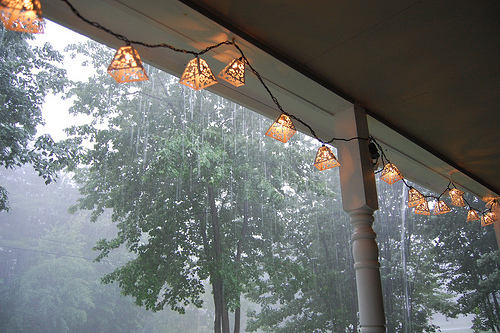Adding an Outside Outlet
 Photo of porch lighting and water by therichbrooks/Flickr Creative Commons.
Photo of porch lighting and water by therichbrooks/Flickr Creative Commons.
Outdoor outlets (properly called receptacles) are super handy for everything we're doing outside these days: working with air- and ear-friendly electric landscaping tools, powering adorable animatronic holiday characters, and throwing elegant al fresco foodie events (or wild au naturel swim parties, or maybe both in the same night). In any case, if you've always wanted an outside outlet and were afraid to tackle the job, you might find its relative simplicity to be a bit surprising, if not downright shocking. And now with that obligatory pun out of the way, let's look at what's involved with the most common types of outlet projects.
Adding an Outlet to a House Wall
This is the simplest way to install an exterior receptacle. And the easiest way to go about it is to tap into an existing receptacle on the interior side of the wall. You connect a new cable to the old receptacle, run the cable through the wall (if you stay in the same stud bay you don't have to drill through any framing) and feed it into an exterior receptacle box mounted to the outside of the wall. The existing circuit must be a standard lighting/receptacle circuit (not the type feeding major appliances or bathrooms), and it must be able to handle the additional load of the outdoor receptacle (the power demands of what you'll plug into the outlet). Garage receptacles are good options because they're often easy to reach from the inside, may be 20-amp (more power) and should be GFCI-protected if they're up to current code (see Outside Outlet Safety, below).
Adding an Outlet to a Yard or Garden
Bringing power away from the house is a much bigger job than installing a basic wall outlet, but it's less complicated than you might think. The hardest part is digging the trench to bury the circuit cable. For that you can hire a contractor to do the job, do it yourself with a rented power trencher or dig the ditch old-school using some good gloves, a pick and shovel and a Costco-size bottle of ibuprofen. Cable trenches typically are 18 inches deep, but that—and every other aspect of the project—is subject to local code rules, so be sure to check with your city's building department. You may be able to tap into an existing circuit, as with the wall outlet. If not, installing a new circuit should not add significantly to the project.
With a basic system, the power cable runs from an exterior wall box or the home's service panel (breaker box), through a vertical conduit (which protects the exposed portion of the cable) and down into the trench. At the other end, the cable emerges from the ground, again protected by conduit, and connects to an exterior outlet box that's mounted to a secure post or other code-approved structure. This setup provides a convenient plug-in location right at your garden or somewhere out in the yard, so you don't have to string out a 100-foot extension cord to trim grass along your property line.
Adding an Outlet to an Outbuilding
Supplying power to a shed, gazebo or writer's retreat (unlike Thoreau, you'll need a place to recharge your tablet) is pretty much the same as adding an outlet to a garden or yard. But with a building, you have the option of installing an outlet on the outside wall of the structure as well as bringing power into the building. Wiring inside an outbuilding generally looks like outdoor wiring, with conduit-protected cables, sealed boxes and GFCI receptacles, but that's a discussion for another article. Powering the building likely will require a new circuit.
Outside Outlet Safety
We all know that water and electricity are like the two bad kids who shouldn't be allowed to sit together in the back of the bus. So there are a couple of rules for keeping these miscreants separated (or to minimize the potential damage if they somehow get together). First, all outdoor receptacles or their supply circuits must be protected by a GFCI (ground-fault circuit interrupter) device. A GFCI shuts off the power to an outlet if it detects even the tiniest of drop in the electrical current flow, such as when you're digging a hole in the rain and your metal shovel cuts into the cord of your landscape lights. All you need for protection is a GFCI receptacle (costs a few bucks more than a standard one) or a GFCI circuit breaker (installs just like a regular breaker, but this is a job for a professional electrician).
Second, outdoor outlets must be installed in a weatherproof electrical box fitted with a special cover that keeps out the elements. A "weatherproof-in-use" cover has a little plastic canopy that swings down to cover the outlet and any cords that are plugged into it. A standard outdoor cover has one or two metal doors that close over the outlet when it's not in use. For things like holiday and landscape lights, which stay plugged in—rain, snow or shine—an in-use cover is best.
The Question You've Been Afraid to Ask
Yes, you most likely will need a permit to add an outside outlet, and you'll definitely need one to add an underground cable. Building codes are strict about outdoor wiring, for one good reason: electricity can get you dead quicker than you can say "zap." So stop weighing the risks of avoiding the law; be a good scout and call your city's building department to discuss your project. When your skinny-dipping party guests keep using their wet hands to turn up the music, you'll be glad you installed your outlet by the book.
Updated April 26, 2018.
Looking for a Pro? Call us (866) 441-6648

Electrical Average Costs
Electricians Experiences

Our Ceiling Fan Journey

Parking Lot Lights Restored So Employees Can Reach Cars Safely



